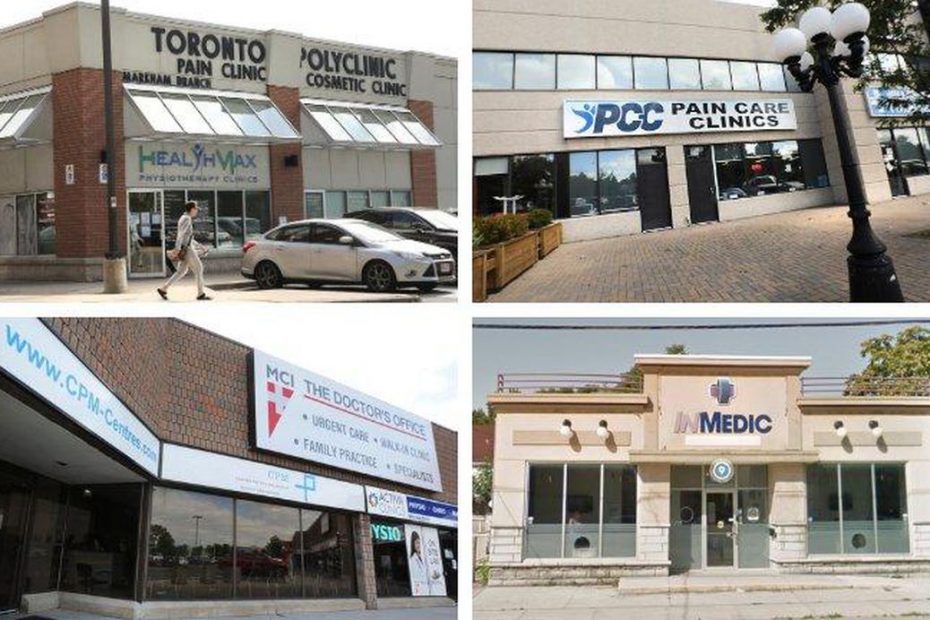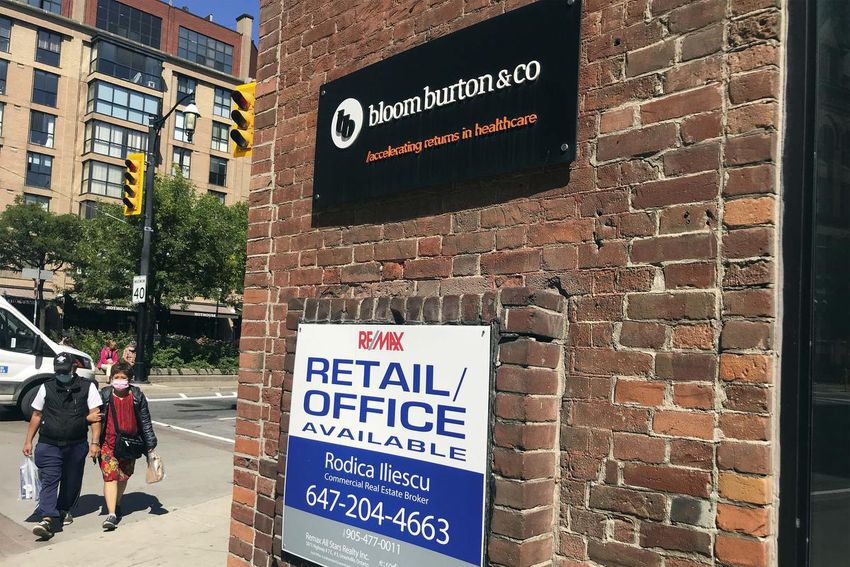Using nerve blocks to treat chronic pain has grown from a fringe, experimental treatment into big business in Ontario.
At the centre of the business model are high-billing doctors. Of Ontario’s 100 top-billing doctors in fiscal year 2017-18, 17 have a pain practice. Nearly 60 per cent of their total billings that year came from nerve block injections.
The vast majority of nerve blocks in Ontario are performed in 99 private pain clinics, an industry dominated by several big chains, including The Centres for Pain Management (CPM), InMedic Pain Management Centres, Pain Care Clinics (PCC) and Toronto Poly Clinics (TPC).
Collectively, doctors at these private clinics bill for millions of dollars in publicly funded nerve blocks each year.
It’s a cosy industry with links between all four chains — via shared current or former staff, common ownership or joint clinics. Their doctors have some of the highest billing totals, while some of the clinics themselves have low overhead.
Clinics say 30 to 40 per cent of their doctors’ billings go to overhead. However, the clinics have several additional sources of revenue beyond billing the publicly funded health plan, including payouts from private insurance. For InMedic and CPM, as little as 19 per cent of their total revenue goes toward overhead.
Deep-pocketed investors have taken interest in the pain chains, trumpeting a profitable future in treating chronic pain patients, both with nerve block injections and, more recently, medical cannabis.
Both PCC and InMedic were founded by former doctors or staff at CPM. Until this month, TPC shared a clinic with PCC in Vaughan.
CPM, which opened its doors in 2005, has seen two defections over the years. Dr. Ganesh Ram and his brother Grishanth, who previously worked for CPM’s parent company, opened InMedic in 2011. In 2014, Dr. Hany Demian and Dr. Nadir Al-Jazrawi left CPM and started PCC.
While Ram’s departure was amicable enough that CPM and InMedic merged in 2018 under a common owner, Neupath Health, the PCC split led to a $15-million lawsuit.
Several months after Demian and Al-Jazrawi resigned, CPM sued them for allegedly breaking their contracts, claiming they had taken confidential business secrets with them when they left, then recruited CPM staff and convinced 2,151 CPM patients to move to PCC clinics.
“CPM has developed and perfected a unique approach to Interventional Pain Management that generates high patient satisfaction and optimizes medical outcomes and clinic profitability,” the statement of claim, filed in 2015, reads.
In their statement of defence, Demian and Al-Jazrawi said they never took any confidential information or induced staff and patients to follow them to their new clinics. The doctors allege they left CPM because it was poorly managed and they had concerns about the “quality of healthcare being provided.”
Their defence also underscored the cost-efficiency of their business model, saying PCC “has no payroll of any kind. … The staff providing services at its pain clinics are all employees of the pharmacies to which the pain clinics are adjacent and from which the pain clinics lease their space.”
Demian and Al-Jazrawi didn’t respond to repeated requests for comment. CPM’s parent company said it has no knowledge of the lawsuit because it was launched under previous ownership and by a different management team. “The current management and owners operate to very high standards,” the company said.
A Star investigation published Monday found top-billing pain doctors capitalize on Ontario’s lax limits on nerve blocks, giving patients weekly injections despite medical guidelines saying the procedure should be done no more than once every three months.
The Star also spoke to more than a dozen chronic pain patients who say nerve blocks have allowed them to live a semblance of a normal life and are even more important as opioid prescriptions are cut back.
The skyrocketing use of nerve blocks has swollen the public’s tab for chronic pain management despite a paucity of evidence to show regular, repeat injections are an effective way to treat chronic pain. Premier Ford said the findings shocked him and Health Minister Christine Elliott said the government will tackle the “excessive” use of nerve blocks billed to the provincial health system.
According to OHIP billing data for 2017-18, the 106 doctors who reported to the College of Physicians and Surgeons of Ontario that they worked for the four chains billed for more than $75.8 million. That’s an average of around $715,000 per doctor.
To put that number in perspective, if pain doctors working for the big four chains were a specialty, it would be the second-highest billing specialization among Ontario physicians, second only to ophthalmology. These doctors receive an average of $724,183 from OHIP annually. Ontario family doctors bill an average of $309,000.
Of the 384 doctors eligible to work in Ontario’s pain clinics, nearly half of them are family physicians, many of whom qualified to practise pain medicine after completing 900 hours of supervised training (this route is no longer available for doctors looking to move into the field).
Under a new Royal College of Physicians pain specialist program, doctors must now undergo seven years of post-MD training.
There are only 24 pain medicine specialists across the province. Under Canada’s specialist training system, a doctor must first specialize in one of eight fields including anesthesiology, neurosurgery or internal medicine, then complete a two-year residency in pain medicine. None of them works for the big four chains of pain clinics. These chains employ 10 of the 194 top-billing doctors in the province.
Loading…
Loading…Loading…Loading…Loading…Loading…
In addition to public OHIP payments, Neupath (which is a part-owner of InMedic and CPM) says it also receives income from private insurance payouts, supplying physicians to correctional facilities and research for pharmaceutical companies. The firm’s public filings show that of the $11.4 million in medical services revenue the company made in the first three months of this year, 19 per cent, or $2.3 million went to overhead.
The pain clinic chains are diversifying into other kinds of treatments that promise to be more lucrative. TPC, under the guidance of medical director Dr. Kevin Rod, is leading the charge on clinic research into medical cannabis.
In a 2018 deal worth $20 million in stock, TPC was acquired by Tree of Knowledge, a publicly traded company that sells medical cannabis products in the U.S. When the deal was announced, Tree of Knowledge CEO Jean-Paul Gaillard didn’t mention nerve blocks. Instead, he touted the profit potential of medical cannabis.
“We are bullish on our ability to differentiate ourselves as a(n)…innovator in medical cannabis,” he said in a release that noted “TPC has become a healthcare leader in the ethical and controlled use of medical cannabis.”
Former Ontario Premier Ernie Eves, who serves as the chairman of TPC’s parent company, Asterion, praised the takeover, saying at the time: “We will be positioned to leverage our cannabinoid and chronic pain research initiatives.”
Meanwhile, CPM has gone public for a second time. A decade ago, CPM traded publicly via its parent company AIM Health Group. It was taken private in 2011. In June 2020, via a complex corporate transaction called a reverse takeover, CPM and InMedic went public via Neupath Health.
Neupath is 41-per-cent owned by an investment banking firm, Bloom Burton & Co., which has the slogan “accelerating returns in healthcare.”
In response to questions, Neupath CEO Grant Connelly said while the clinics are cash-flow positive, they are not a high-margin business.
“Ultimately, we are helping provide a public service, and maximizing profits to the detriment of patient outcomes is neither appropriate nor acceptable to management or our stakeholders,” he said.
Citing research into the cost of patient wait times, a Neupath spokesperson said “we can demonstrate that every $1 invested in the services of a pain practitioner results in $1.57 of public spending savings (provincially insured health services and lost tax revenue) and $6.13 in private spending (out-of-pocket costs, services covered by third party insurance, and lost wages.).”
Late last year, PCC announced it was opening a new clinic in Vaughan. What the announcement didn’t say is that the clinic would be shared with TPC and housed in a Jack Nathan Health Medical Centre in Walmart.
The joint clinic was one-of-a-kind, but the deal with Walmart was not. TPC had a contract with the Jack Nathan clinic chain to partner in 72 Walmart locations in six provinces. It was a growth opportunity touted by Tree of Knowledge when it took over TPC.
“The companies will have an opportunity to implement specialty pain clinics with potential access to…1.5 million patient visits per year in Canada,” stated a December 2018 press release.
TPC told the Star Tuesday that it closed its Walmart clinic this month due to high costs and COVID-19. A receptionist at the clinic had said last Friday that the clinic was open, operating as both TPC and PCC and offering nerve blocks.
Jack Nathan confirmed Tuesday, however, that the deal putting TPC nerve block services in Walmarts was terminated this month.
Meanwhile, PCC was due to expand to the Cayman Islands this year, though its website no longer mentions the upcoming opening.

